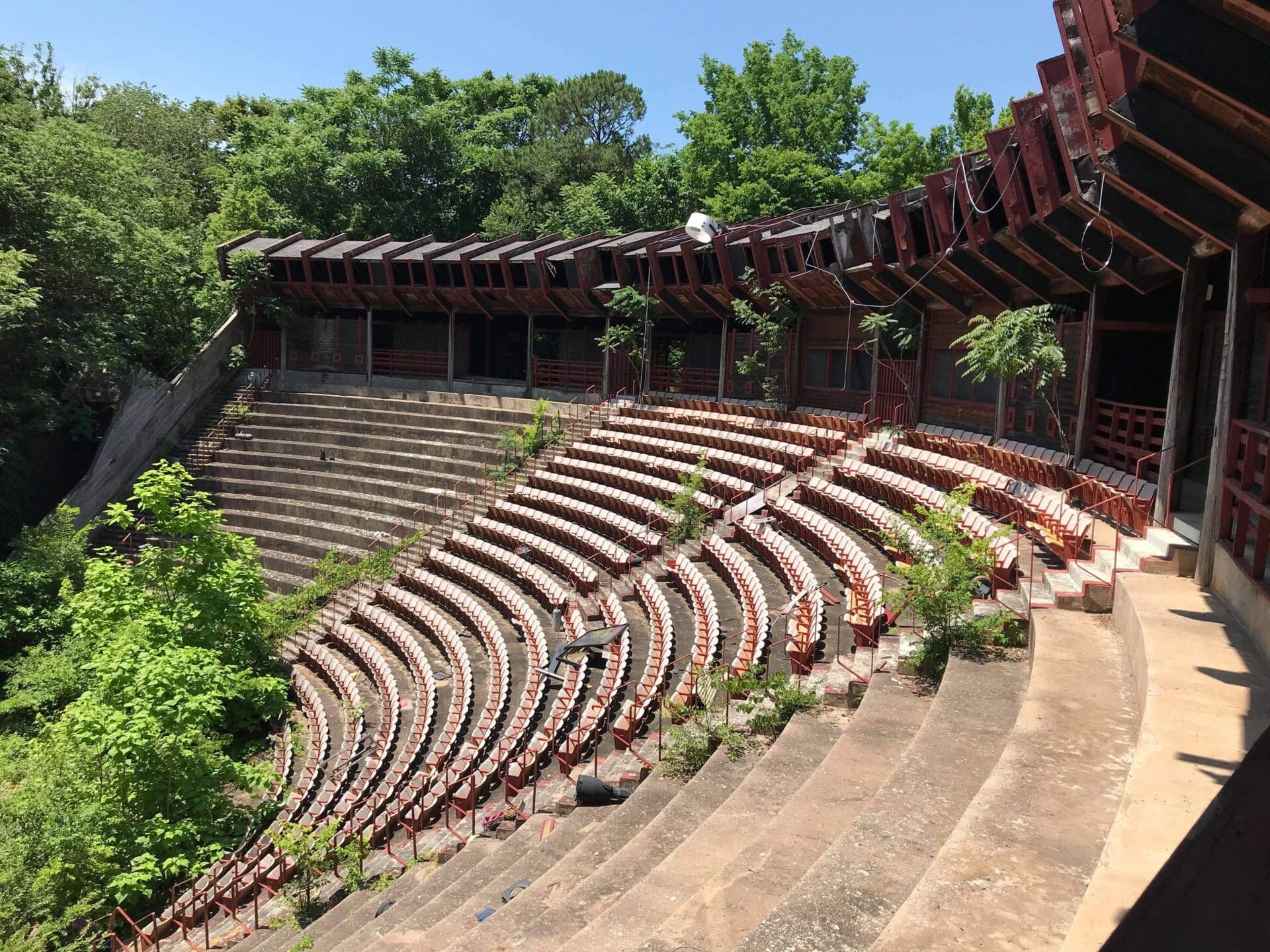| City/Town: • Tahlequah |
| Location Class: • Amusement |
| Built: • 1969 | Abandoned: • 2005 |
| Historic Designation: • Native American Heritage Site |
| Status: • Abandoned |
| Photojournalist: • Brian Brophy |

Tsa-La-Gi Amphitheater was the second of a four-phase Cherokee Cultural Center on 44 acres in Tahlequah Oklahoma. The amphitheater was designed by CHC co-founder Charles “Chief” Boyd who had a degree in architecture. The amphitheater took on the shape of a fan with very steep seating surrounding a thrust stage in the center. Just behind the main stage were the dressing rooms and a prop mountaintop created using actual flora tieing in the beautiful nature surrounding the grounds.
Opening on June 27, 1969, the debut show was “Trail of Tears” which would run through August. The amphitheater had a capacity of 1,800 which it sold out many times. The show depicted 26 of Oklahoma’s very own Native Americans to trace the story of the Cherokee’s arrival to Oklahoma. Dr. Kermit Hunter wrote the play as a companion to his outdoor drama Unto These Hills, which had been performed annually in Cherokee, North Carolina, since 1949. It also featured “Mountain Windsong” by Cherokee author Robert J. Conley, as well as art shows, Tibetan monks and other plays.

Actors in Oklahoma were accustomed to the Oklahoma sweltering heat but that made it no less bearable. Another amphitheater in Oklahoma, Discoveryland had its actors also performing in the humid hot summers. But Tsa-La-Gi Amphitheater became the first amphitheater with “air conditioning,” using vents pointed in the direction of the stage to offer the dancing actors a few degrees of comfort.
The play was put on a pause in 1997, award winner Joe Sears rewrote the Trail of Tears script, this version was used for the revival in 2001-2003. Also like Discoveryland, which was the home of Roger and Hammerstein’s Oklahoma! the Tsa-La-Gi Amphitheater became a huge tourist attraction. In 2002 the show was named one of “the top one hundred events in North America” by the American Bus Association. It was revised again by local playwright Layce Gardner in 2004, and then the finalized version, by Richard Fields, was produced in 2005.
But over the years outdoor amphitheaters lost traction resulting in low attendance and revenue causing many to shut down across the nation. In addition, the post-9/11 world of tourism had been deeply affected as well. The final performance for the Trail of Tears play at the Tsa-La-Gi Amphitheater was in 2005. Also noted as one of the reasons for closure was the non-compliance with the Americans With Disabilities Act. The massive amphitheater was abandoned and left to become overgrown with vegetation.
“The task force is currently conducting marketing research to evaluate the situation, the needs and capabilities of the theater and what it should ‘look’ like in the future,” said a spokesperson. “I’m ashamed that it has been allowed to suffer the neglect it has, but realize, too, the finances are the reason.”
In more recent years an assessment of the amphitheater and a petition has been circled around titled “Save the Cherokee Heritage Center Amphitheater.” One local said, “The amphitheater has been part of the tribal community for a long time, and I think it needs to be restored just for cultural reasons and for our economy. A lot of people have never heard about it, and I’d hate to see it go down to nothing or just be torn out. It still, from what I can tell, has a good, solid structure.” While nothing has been solidified or released as of August 2022 on whether or not a course of action has been adopted to bring the grounds back the interest in saving history has less than diminished.
Gallery Below of Tsa-La-Gi Amphitheater
https://www.tahlequahdailypress.com/news/local_news/a-tarnished-treasure/article_60245a96-8ae3-59a7-93bb-7c679ab7c094.html
https://www.cherokeephoenix.org/culture/chc-amphitheater-was-something-to-remember/article_97613e34-0d10-51ab-a2ac-78ef08ae07c9.html
https://www.tahlequahdailypress.com/news/saving-tsa-la-gi-movement-is-growing-to-restore-dilapidated-cherokee-heritage-center-amphitheater/article_dc172bd6-8b61-5a9b-b464-de210a94beb0.html
Daily Oklahoman (Oklahoma City), 18 September 1961, 25 May 1969, 27 April 2001, and 11 August 2002.
Marjorie J. Lowe, “‘Let’s Make it Happen’: W. W. Keeler and Cherokee Renewal,” The Chronicles of Oklahoma 74 (Summer 1996).
George Shirk, “‘Trail of Tears’ Drama,” The Chronicles of Oklahoma 47 (Autumn 1969).
James Vance, “The Theatre at Tsa-La-Gi: The Trail of Tears Drama [Souvenir Program],” (Tahlequah, Okla.: Cherokee National Historical Society, Inc., 1983).
[Photograph 2012.201.B1282.0329], photograph, July 4, 1977; (https://gateway.okhistory.org/ark:/67531/metadc596871/: accessed August 15, 2022), The Gateway to Oklahoma History, https://gateway.okhistory.org; crediting Oklahoma Historical Society.
[Photograph 2012.201.B1282.0335], photograph, July 16, 1991; (https://gateway.okhistory.org/ark:/67531/metadc599884/: accessed August 15, 2022), The Gateway to Oklahoma History, https://gateway.okhistory.org; crediting Oklahoma Historical Society.
https://www.newspapers.com/image/14957315/?terms=%22tsa-la-gi%22&match=1
https://www.newspapers.com/image/451771778/?terms=%22tsa-la-gi%22&match=1
https://www.newspapers.com/image/451748633/?terms=%22tsa-la-gi%22&match=1
https://www.newspapers.com/image/662144474/?terms=%22tsa-la-gi%22&match=1
https://www.newspapers.com/image/662209261/?terms=%22tsa-la-gi%22&match=1
If you wish to support our current and future work, please consider making a donation or purchasing one of our many books. Any and all donations are appreciated.
Donate to our cause Check out our books!


































Back in 1969 my neighbors were thrilled by this theater, and show, and would round up everybody they could to make the 45 mile journey to go see this amazing icon